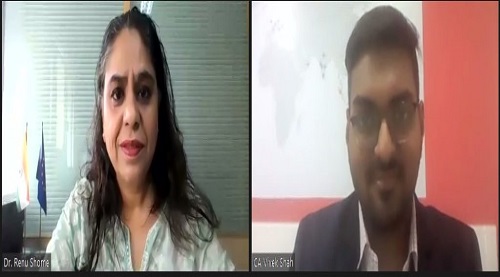The Council of EU Chambers of Commerce in India along with Hasmukh Shah & Co LLP organized a webinar on “What Recent GST Amendments Mean to Indian Businesses” on April 8, 2021.

The speaker was CA Vivek Shah, Associate Partner, Hasmukh Shah & Co LLP (HSCo). The webinar covered the benefits of the QRMP scheme, how to maximize ITC Claim, Importance of March GST returns, GST Amendments in Budget 2021, E-invoicing system and its implementation and key takeaways to become GST Compliant.
Dr. Renu Shome, Director, EU Chambers welcomed the attendees she briefed the attendees with the activities of the Chamber and also introduced CA Vivek Shah.
CA Vivek Shah, began the webinar by introducing the GST. He mentioned that GST replaced many indirect taxes in India such as the excise duty, VAT, services tax, etc. he mentioned about the frequent changes in the GST. There were 953 amendments in GST till 31.12.2020 which means five changes per week.
Explaining about the QRMP Scheme he said that Registered Tax Payers filing GSTR 3B and whose turnover is upto 5 crores in FY 2019-20 and in case whose turnover in FY 2020-21 does not exceed 5 crores are eligible under the QRMP Scheme. The Registered Tax Payers filing GSTR 3B whose turnover is above 5 crores in FY 2019-20 and whose turnover in FT 2020-21 exceeds 5 crore are not eligible under this scheme. The time to Opt In/ Opt Out of the scheme is the 1st day of the second month of the preceding quarter till the last day of the 1st month of the quarter. One should Compulsory opt out from next quarter of the month in which turnover crossed Rs. 5Cr. Where there is nil tax liability the registered person may not deposit any amount for the said month. If a payment is furnished beyond the due date, interest would be payable @18% p.a. for the tax liability net of ITC. No late fee is applicable for delay in payment of tax in first two months of the quarter.
There are few challenges for the taxpayer under the ITC (Input Tax Credit) such as Reconciliations complexities have increased. Static Statement – Difficulty in claiming ITC. CA Shah further added that the best practice to be followed for claiming the ITC accurately was to obtain Proper Tax Invoice for any Goods / Services procured for business, record the invoice in books in the same month in which it is issued, make payments to vendor within prescribed time limit, Identify the block credits at accounting entry level, compare GSTR-2A for cumulative period with books of accounts, periodic reconciliation of Books with GSTR-2A and GSTR-2B, periodic follow up with vendors to make sure that ITC is reflecting on portal and not to forgot to take credit of GST paid under RCM.
He mentioned the points that are required to be remembered while filing the GST returns for the month of March. He added that in case if any tax is paid inadvertently then the same can be adjusted against actual tax liability. However, in case if tax is collected wrongly from the customer then it needs to be completely remitted to the Govt. and cannot be adjusted against other liability.
He further discussed the Budget 2021. He mentions that as per Budget 2021 Input tax credit (ITC) cannot be availed unless reported by the supplier of goods and services as the supplies in the GST returns. The Finance Bill 2021 proposes to amend Section 50 of the Central Goods and Services Tax (CGST) Act to substitute the proviso to sub-section (1) so as to charge interest on net cash liability retrospectively with effect from the July 1, 2017. For release of goods/vehicle in case of default of E way bill, penalty equal to 200% is payable earlier the penalty was 100%. He added that the finance minister has now announced that businesses having a turnover above Rs 5 crore won’t be required to get their accounts audited by a chartered accountant. Similarly, the earlier need for an external certification of annual reconciliation statement has been abolished. Now, businesses can rely on self-certification for this purpose.
After discussing Budget 2021 he threw some light on e-invoicing. He mentioned that E-invoicing’ or ‘electronic invoicing’ is a system in which B2B invoices are authenticated electronically by GSTN for further use on the common GST portal. Under the proposed electronic invoicing system, an identification number will be issued against every invoice by the Invoice Registration Portal (IRP) to be managed by the GST Network(GSTN). All invoice information will be transferred from this portal to both the GST portal and e-way bill portal in real-time. Therefore, it will eliminate the need for manual data entry while filing ANX-1/GST returns as well as generation of part-A of the e-way bills, as the information is passed directly by the IRP to GST portal.
He concluded the webinar by mentioning key takeaways. The webinar was ended by an interactive Q&A session.
